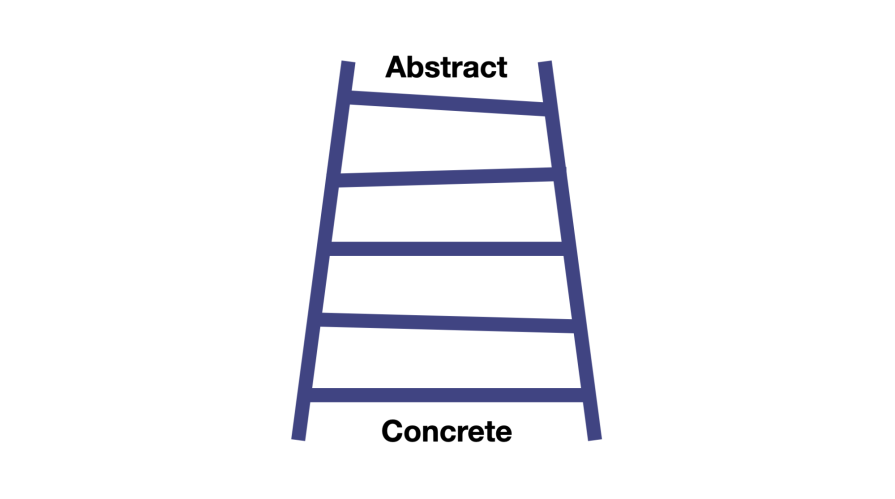Have you ever had the experience of sitting in a meeting where the conversation seemed stuck in the clouds, full of grand visions but lacking any concrete steps to get there? Or perhaps you’ve been in the opposite situation, bogged down in minute details without any clear sense of the bigger picture?

As a product manager, you need to strike the right balance between high-level strategic thinking and detailed execution to drive your product’s success. Luckily, the “ladder of abstraction” can help you do just that.
This article explains how you can leverage the ladder of abstraction to construct more effective messages and find a balance between high-level visions and practical actions.
Introduction to the ladder of abstraction
The ladder of abstraction is a concept used to illustrate the range of thinking from the abstract (top of the ladder) to the concrete (bottom of the ladder). Linguist S.I. Hayakawa introduced this concept in his book “Language in Thought and Action.” The idea is that at the top of the ladder, you have more abstract terms, and as you move down, terms become more concrete.
This helps in understanding how language and thought interact and how you can communicate more effectively by choosing the appropriate level of abstraction. The ladder can also be used as a framework that helps balance high-level concepts and specific details:

The bottom of the ladder consists of concrete items. These are “grounded” and “down to earth” as illustrated in the image. Think of specific, tangible facts such as your favorite restaurant or the highway you take everyday.
In an office setting, concrete items can be:
- A spreadsheet
- A release schedule
- A spec document
On the other hand, the top of the ladder consists of more abstract ideas and concepts. These are more general and tend to be philosophical such as concepts like freedom, well-being, or happiness.
In an office setting, on the top of the ladder, the abstract ideas can be:
- Your company vision
- Market needs
- High-level product roadmaps
Tips for moving up and down the ladder
Moving up or down the ladder requires different actions. To help you get started, consider the following:
Moving down the ladder
Although staying on the top of the ladder can sound inspirational and motivational, you should ensure the product plan isn’t superficial and hollow. While brainstorming, ask “how” questions to move down the ladder and be more specific:
- How are we going to achieve this goal?
- How are we going to enhance the user onboarding process?
- How can we simplify the ordering process?
Also, when available, cite data and statistics to set baselines and make the goal measurable. Providing examples is also a good way to help the team be on the same page.
Moving up the ladder
In brainstorming, presentations, meetings, or any situations, ask “why” questions to move up the ladder and tie the actions back to the high-level vision and objectives. Also, by asking the “why” questions, the audience understands the rationale behind the actions and sees the bigger picture. Here are some “why” questions in the product management context:
- Why is this important?
- Why are we adding a chatbot to our landing page?
- Why are we building the CRM system in-house?
The ideal balance of abstraction
To communicate effectively, you need to climb up or down the ladder of abstraction while speaking. You should plan strategically (abstract) with actionable items (concrete) when working on products. Sticking on either side of the ladder can harm the growth of the product.
A good PM finds a balance between abstract and concrete in product planning. You might wonder what happens when you get caught on one side of the ladder. Either side poses its own set of problems:
Problems with being too “abstract”
At the top of the ladder, you deal with abstract concepts such as the overall vision, mission, and goals. This high-level thinking involves understanding market trends, customer needs, and the competitive landscape. However, what may be the side effect if you only focus on this level?
- Lack of detail for executionWhen high-level visions and strategies lack the necessary details, they’re impossible to act on. Teams may struggle to understand their specific tasks and how to achieve their goals. This can lead to confusion and inefficiency
- Disconnect with realityAbstract thinking can sometimes overlook practical constraints such as technical limitations, budget, and time. Plans and strategies may become unrealistic and unachievable, resulting in failed projects or unmet goals
Problems with being too “concrete”
One of your most important tasks as a PM is translating the vision into actionable items. As PMs move down the ladder, they tend to focus on more specific elements such as product features, user stories, and technical requirements. However, you don’t want to fall into the trap of thinking too concrete. Here are the problems you may be facing if you’re stuck at the bottom of the ladder:
- Lack of strategic directionFocusing solely on details can cause you to lose sight of the bigger picture and overall goals. The product may end up being a collection of features without a coherent strategy, making it difficult to achieve long-term success. Users may be overwhelmed by the features without gaining the benefits from them
- Poor stakeholder communicationDetailed, technical discussions may not resonate with stakeholders who need to understand the strategic value and impact. Misalignment with stakeholders can result in a lack of support and resources for the product and further undermine its success.
By navigating up and down the ladder, you can ensure that your teams are strategically aligned and equipped with the detailed guidance necessary to execute their vision.
7 practical applications for product managers
Ultimately, product management is the art of finding the balance. This section shows how you can remain concrete while still having abstract thoughts:
- Alignment with business goals
- Abstract — Product managers communicate the overall vision and strategic goals, which ensures the product aligns with the strategic business objectives and company values
- Concrete — Conversely, product teams must also get into the details of the features, user stories, and specific tasks
- User need analysis
- Abstract — At a high level, product managers need to grasp the general needs, desires, and pain points of their target users
- Concrete — Translating these abstract needs into specific user requirements, personas, and user stories. Good product managers create detailed requirements that guide development teams effectively
- Prioritization and roadmapping
- Abstract — High-level prioritization involves deciding which features align best with the product’s strategic goals
- Concrete — This involves breaking down those high-level priorities into specific tasks and milestones that can be executed by the team
- Prototyping and testing
- Abstract — Developing hypotheses about how users will interact with the product and what their experience will be
- Concrete — Building prototypes and conducting usability tests to gather concrete feedback and iterate on the design
- Communication and collaboration
- Abstract — Product managers can use more abstract language to discuss the vision, market positioning, and potential impacts, especially when communicating with executives, investors, or other high-level stakeholders
- Concrete — When working with developers, designers, and other technical team members, the communication needs to be much more concrete, focusing on specifications, requirements, and detailed plans
- Feedback and iteration
- Abstract — Synthesizing feedback into general themes and areas for improvement. Understanding broad trends and patterns from customer feedback
- Concrete — Implementing specific changes and adjustments based on user feedback and testing results. Addressing specific issues and incorporating detailed feedback into the product development process
- Metrics and analytics
- Abstract — Defining what success looks like, such as increasing user engagement, larger market share, etc
- Concrete — Identifying specific metrics and KPIs, and analyzing data to track progress and make informed decisions
Final thoughts
With the ladder of abstraction, you can navigate between abstract ideas and concrete details with ease. This approach not only enhances clarity and alignment across your team, but also ensures that innovative ideas are grounded in practical implementation.
Try to incorporate the ladder of abstraction into your daily routine until it becomes second nature. Good luck! Report back with any comments or questions you have.
Featured image source: IconScout